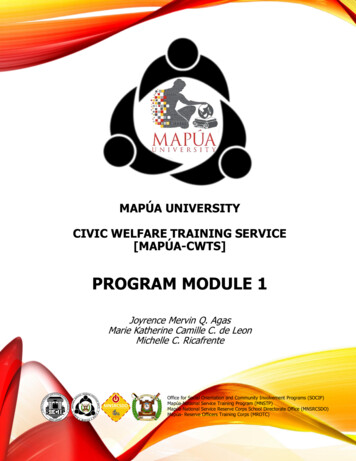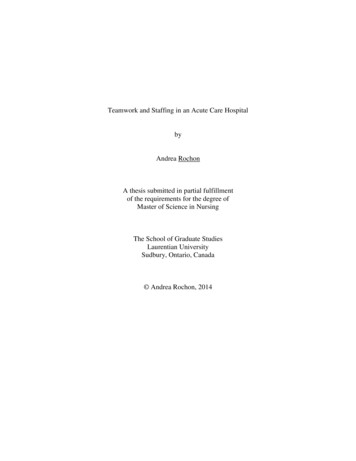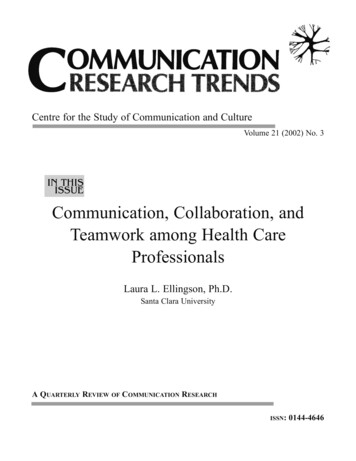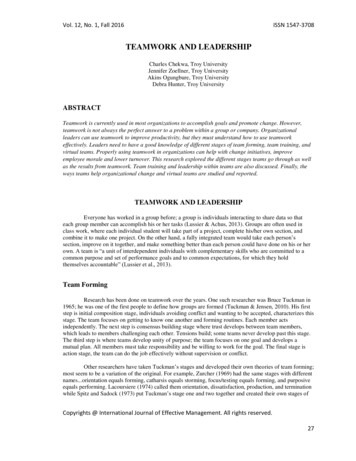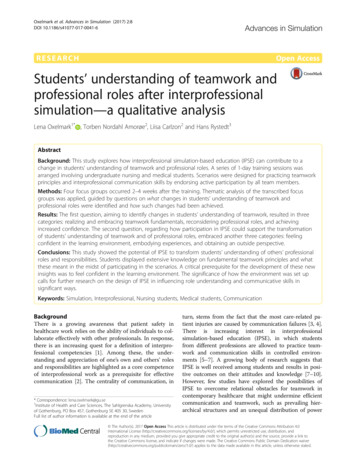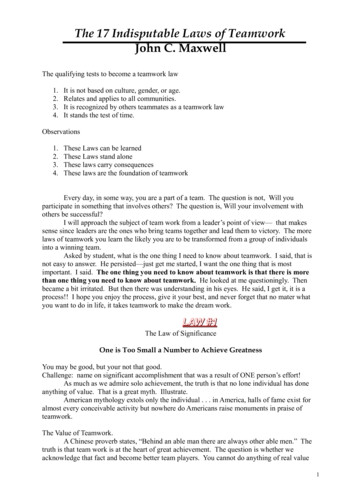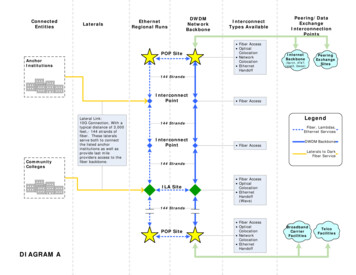
Transcription
ISSN 1803-4330peer-reviewed journal for health professionsvolume VI/1 April 2013Evaluation of Teamwork in HealthcareDana DolanováDepartment of Nursing, Faculty of Medicine, Masaryk University BrnoDepartment of Nursing, Faculty of Health Care, Catholic University RužomberokABSTRACTObjective: The theoretical study aimed to briefly characterize the team and teamwork in healthcare, its assessment,and to present selected measurement tools designed to assess teamwork in healthcare.Background: The paper centred on validation studies of several authors (Kalisch, Weaver, Salas, 2009; Kalisch,Lee, Salas, 2010; Kalisch, Lee, Rochman, 2010, Shteynberg, Sexton, Thomas, 2005; Sexton, Helmreich, Neilands etal. 2006; Ryan, 2008, Ryan, Cott, 2008), whose focal point was the development of measurement and assessmenttools that investigate the efficiency, functionality, and team culture of nursing and/or multi-disciplinary teamsin healthcare.Methods: The measurement tools for assessing teamwork in health care published and validated internationallyhave been analyzed analytically and synthetically. The analysis was based on research of peer-reviewed full-textonline databases (EBSCO, SCOPUS, Web of Knowledge).Conclusion: In connection with the growing demand for all types of teams working in the healthcare sector, it isnecessary to expand the knowledge base for the specific issues of the functioning of the team in healthcare andthe assessment of its effectiveness or functionality. Implementation of the selected measurement tools into Slovakpractice would require a profound national validation, the process of which is currently under preparation.KEY WORDSteam, teamwork, health care, nursing, teamwork assessment, teamwork questionnaire, teamwork surveyINTRODUCTIONTeamwork is vital in health care because the treatmentof a single patient requires a number of interventionsprovided by many different professionals. In general,a team is a small group of people working together toward a common goal.An apt definition of teamwork that easily appliesin healthcare was given by Hoegl and Gemuenden(2001, p 436), who defined teamwork as “the quality of both task-related and social interaction withinteams.” According to Cohen and Bailey (1997, p 241)the following three aspects of the above definition arenoteworthy:a) teamwork expresses the interaction between individuals in contrast with the quality of their jointactivities (e. g. appropriateness of their jointly developed treatment plan),b) teamwork is the result of task-related and social interactions, andc) specifies that the interactions take place between themembers of the team.In relation to the relevance of team and teamwork inhealthcare it is necessary to seek methods for theirimprovement; therefore the present study primarilyfocuses on the evaluation of nursing and multidisciplinary teams.METHODSThe analytic-synthetic approach involved various analyzed measuring tools for assessing the functioning ofteams and teamwork in healthcare. The analyses werebased on electronic resources generated through oursearch of peer-reviewed full-text online databases(EBSCO, SCOPUS, Web of Knowledge), which werein Slovak, Czech, and English and included the following key words: tím, tímová práca, zdravotníctvo,ošetrovateľstvo, hodnotenie tímovej práce, dotazníktímovej práce, tým, týmová práce, zdravotnictví, ošetřovatelství, hodnocení týmové práce, dotazník týmovépráce, team, teamwork, healthcare, nursing, teamworkassessment, and teamwork questionnaire. The abovedatabases generated over 1,500 results for the searchISSN 1803-4330 volume VI/1 April 20136
period from 2000 to 2011. Gradually sorting the resultsto eliminate those that did not meet the research design we ultimately arrived at 123 results (EBSCO – 32,SCOPUS – 23, and Web of Knowledge – 68). The finalphase involved 30 full-text studies. The criterion forselecting the results was that the measurement tool wasapplicable either in a multidisciplinary team or a nursing team. On this basis, we chose two measuring toolsthat examine multidisciplinary teams (DTEAM, SAQ)and one that assesses nursing teams (NTS). The presentstudy hence focused on validation studies of severalauthors (Kalisch, Weaver, Salas, 2009; Kalisch, Lee,Salas, 2010; Kalisch, Lee, Rochman, 2010, Shteynberg,Sexton, Thomas, 2005; Sexton, Helmreich, Neilands etal. 2006; Ryan, 2008, Ryan, Cott, 2008), whose focalpoint was the development of measuring and evaluating tools that investigate the efficiency, functionality,and team culture of nursing and/or multi-disciplinaryteams in healthcare.TEAMWORK IN HEALTHCAREAccording to Jarošová (2000, p 41), as medical care isincreasingly specialized, patient care is more and morecarried out by a cooperating group of functionally dependent health professionals.Teamwork is integral to a holistic approach to patient care, to satisfying all the patient’s needs, to eliminating adverse symptoms of the disease, and to fullycuring the patient if possible. In healthcare the teamis usually multidisciplinary, generally including physicians, nurses, medical assistants, healthcare supportworkers, physical therapists, nutritional therapists, psychotherapists, orderlies, social workers, clerics, volunteers, technical professions, and last but not least alsostudents of all medical and social fields, the patient, andtheir family. A key element in the formation of the teamis the selection of members, who need to take the bestcare possible of all the needs of not only the patient butalso the entire team, and thus fulfil the set objectives.Nowadays, teamwork characterizes modern nursingand medicine. It aims not only to cure the patient or atleast ensure the best possible quality of their life, butalso support the health of the entire population.TEAMWORK ASSESSMENTIn order to assess teamwork in healthcare, it is necessary to understand the basics of team functioning andalso the specifics of its functioning. An essential step inthe preparation for the evaluation of individual teams isthe selection of an adequate research method. The psychometric approach appears pivotal for the measurement and evaluation of the efficiency and functionalityof medical teams. According to Hayes (2005, p 112),the most popular general psychometric approaches toteam assessment include:a) Belbin Team-Role Self-Perception Inventory (BTRSPI)– assessing team roles according to Belbin (2003).b) Sixteen-factor questionnaire (16PF) – assesses16 personality factors in adults; used in clinicalpractice and education, as well as in work and organizational psychology.c) Occupational Personality Questionnaire (OPQ) –evaluates 30 different aspects of an individual’s behaviour, interests, and characteristics at work.d) Team Climate Inventory (TCI) – defines five factorsthat have a major impact on innovation at work(participative safety, support for innovation, vision,task orientation, social desirability). All the factorsare further divided into subscales that assess different aspects of the working atmosphere in the team.Baker and Salas (1992, p 473–475) also studied theprinciples of team assessment, identifying the following six principles for team evaluation:a) Understanding teamwork requires a solid theory astheory is the basis of the measurement instrument,which determines what is actually evaluated.b) Both the situation and the maturing of the teamaffect the team capacities, hence only repeated observation in different situations and points in timewill help identify the team skills that are the mostdominant and the most important.c) It is not practical to evaluate teamwork solely basedon tools that rely on personal testimony or are atsecond-hand. As team members are likely unawareof the team’s social dynamics as they work, someform of direct observation will always be required.d) Teamwork assessment tools need to be developed,implemented, and evaluated in different types ofteams and environments. Without it will not bepossible to elaborate and develop theory or measurement tools or identify the basic mechanisms andfactors.e) Both the evaluator and the teamwork measurementtool must be reliable. Reliability needs to be assessedat two levels: the observer level, as observers areextremely important for overall assessment, and onthe level of internal consistency and stability overtime.f) A thorough validation of measurement to ensurethat users acquire accurate data for the assessmentof work and for training purposes.Another, different approach to team performance assessment is the approach of Katzenbach and Smith(1993 In Hayes, p 115–117), who propose monitoringISSN 1803-4330 volume VI/1 April 20137
the team effectiveness with the “Team PerformanceCurve”. Instead of using the psychometric methods,this approach focuses on the impact of the team ina company and the role the company plays in fulfilling the team task. The approach distinguishes the workgroup, the real team, the pseudo team, the potentialteam, and the high performance team.nal consistency of the scale was confirmed using Alfacoefficient, which scored 0.94 for all 33 items in totaland from 0.74 to 0.85 for the individual subscales. Thetest-retest reliability coefficient scored 0.92 in all theitems in total, while each subscale had the coefficientranging from 0.77 to 0.87. Table 1 indicates the reliability of NTS teamwork measurement.TEAM ASSESSMENT TOOLS IN HEALTHCAREBased on the above set criteria, the following threetools were selected from a variety of reliable and validated questionnaires designed to measure and evaluatethe effectiveness of medical teams:Table 1 Measurement of NTS reliability (n 1,758) (Kalisch, Lee, Salas, 2010)1. Nursing Teamwork Survey (Kalisch, Lee, Rochman,2010, Kalisch, Lee, Salas, 2010, Kalisch, Weaver, Salas,2009)The Nursing Teamwork Survey (NTS) is a questionnaire that assesses nursing teamwork at in-patientwards. Despite there being many theories that defineteamwork, the basic NTS framework was developedbased on Salas’ teamwork theory (Salas, Sims, Burke,2005 In Kalisch, 2010, p 44) because its foundation isteam behaviour and a practical explanation of teamwork dynamics. This framework comprises five basicelements of teamwork: (a) team orientation – cohesiveness and the group’s awareness of itself as a team,(b) team leadership – structure, direction, and supportprovided by a formal leader and some of the teammembers, (c) mutual performance monitoring – teamawareness and mutual observation of individual teammembers, without them neglecting their own work,(d) backup – team members help each other with theirtasks and duties, (e) adaptability – adjustment of theworking environment as it changes; and three coordination mechanisms: (a) communication – active exchange of information between two or more membersof the team, (b) sharing of mental models – collectivemindset, (c) mutual trust – the belief that individualteam members will act toward supporting the objectives of the team. The NTS is a validated psychometricmeasurement tool designed primarily for the evaluation of nursing teams at in-patient wards, which usesa five-point Likert scale to evaluate the replies: rarely,25% of the time, 50% of the time, 75% of the time,always. It consists of 33 key items, divided into five subscales inspired by Salas’ teamwork theory (see above):(a) trust, (b) team orientation, (c) backup, (d) sharedmental model, (e) team leadership.The questionnaire also contains questions about thedemographic data of the respondents, items focusingon work satisfaction, and the number of patients therespondents took care of in their last shift. The al modeTeamleadershipTotalteamworkSum ofsquares868.540Degrees 953.29917526.9380.00571.74217569.7170.002. Safety Attitudes and Safety Climate Questionnaire(Sexton, Helmreich, Neilands et al. 2006; Shteynberg,Sexton, Thomas, 2005)Another selected questionnaire measuring teamworkperformance in healthcare was the Safety Attitudes andSafety Climate Questionnaire (SAQ). The SAQ was developed for intensive care medicine, operating theatres,standard inpatient wards, and the outpatient sphere.Each version of the SAQ contains identical items, whichare only slightly modified depending on the researchedclinical area. The SAQ identifies respondent opinionsthrough 6 factors, which are analytically derived fromthe spheres of the setting: (a) sphere of teamwork climate, (b) sphere of safety climate, (c) sphere of job satisfaction, (d) sphere of perceptions of management,(e) sphere of working conditions, (f) sphere of stressrecognition. The SAQ is a single-page (double-sided)questionnaire, which contains 60 items and demographic information such as age, sex, and nationality.It takes 10–15 minutes to complete the questionnaire.The answer to each of the 60 items is rated on a fivepoint Likert scale (strongly disagree – somewhat disagree – neither agree nor disagree – somewhat agree –strongly agree). Some items are negatively worded;these therefore need to be reverse coded. At the end ofthe questionnaire the authors provide space for comments. Each SAQ version in the current study includesthe section “Communication and Cooperation”, whererespondents express their experience with the qualityof collaboration and communication, which they haveISSN 1803-4330 volume VI/1 April 20138
with all the care providers at their ward/clinic (such asdoctors, medical students, nurses, etc.). This part of thequestionnaire also processes response with a five-pointLikert scale (very low – low – corresponding – high –very high). SAQ reliability was assessed with Raykov’sρ coefficient. The SAQ scale scored ρ 0.90, which indicates its high reliability.3. Dimensions of Teamwork Survey (Ryan, 2008,Ryan, Cott, 2008)The last tool assessing the team culture in multidisciplinary medical teams is the Dimensions of TeamworkSurvey (Dteam). The Dteam was developed to carry outregular surveys of team culture, which should be partof the internal processes (part of the team information system) of multidisciplinary medical teams. TheDTeam team culture parameters are measured at sevenlevels of team culture: (a) customer and inter-team issues, (b) team-member strengths and skills, (c) communication and conflict management, (d) roles and interdependence, (e) clarity of team goals, (f) decision-makingand leadership, (g) organizational support. Responsesto each item range on a six-point Likert scale fromstrongly agree (1), moderately agree (2) slightly agree(3), slightly disagree (4), moderately disagree (5) tostrongly disagree (6). Once the survey has been completed, points are awarded based on the key providedin a table, which also divides the questions into sevendimensions. The final score can be evaluated as overallor for each dimension separately. Negatively wordeditems need to be reverse coded (items marked with anasterisk). The validity and reliability of the questionnaire were validated using standard test protocols (seeTable 2).CONCLUSIONInternational scientific periodicals on healthcare,nursing, and healthcare management publish a greatamount of information about team and teamworkand its evaluation in the mentioned fields. With thegrowing demands on all types of teams operating inthe health sector, it is desirable to expand the knowledge base with the specific issues of the functioning ofteams in healthcare and the assessment of their effectiveness or functionality. The next stage of research ispreparing national validation of the selected measuringtools (NTS, SAQ, Dteam) for teamwork assessment inhealthcare.REFERENCESBAKER, D. P., SALAS, E. 1992. Principles for measuringteamwork skills. Human Factors: The Journal of theHuman Factors and Ergonomics Society. 1992, vol. 34,no. 4, p. 469–475. ISSN 0018-7208.BELBIN, R. M. 2003. Team roles at work. 1st ed.Amsterdam: Elsevier, 2003. 141 s. ISBN 0750626755.COHEN, S. G., BAILEY, D. E. 1997. What Makes TeamsWork: Group Effectiveness Research from the ShopFloor to the Executive Suite. Journal of Management.1997, vol. 23, no. 3, p. 239–290. ISSN 0149-2063.HAYES, N. 2005. Psychologie týmové práce: strategieefektivního vedení týmů. 1st ed. Prague: Portál, 2005.ISBN 8071789836.HOEGL, M., GEMUENDEN, H. G. 2001. TeamworkQuality and the Success of Innovative Projects:A Theoretical Concept and Empirical Evidence.Organization Science. 2001, vol. 12, no. 4, p. 435–449.ISSN 1526-5455.JAROŠOVÁ, D. 2000. Teorie moderního ošetřovatelství.1st ed. Prague: ISV nakladatelství, 2000. 133 s.ISBN 8085866552.KALISCH, B., WEAVER, S. J., SALAS, E. 2009. What DoesNursing Teamwork Look Like? A Qualitative StudyJournal of Nursing Care Quality. 2009, vol. 24, no. 4,p. 298–307. ISSN 1057-3631.KALISCH, B., LEE, H., SALAS, E. 2010. The Developmentand Testing of the Nursing Teamwork Survey. NursingResearch. 2010, vol. 59, no. 1, p. 42–50.ISSN 0029-6562.Table 2 Verification of Dteam validity and reliability (Ryan, 2008)Teamwork dimensionCustomer and inter-team issuesTeam-member strengths and skillsCommunication and conflict managementRoles and interdependenceClarity of team goalsDecision-making and leadershipOrganizational supportInternalconsistency(n ity(n liability(n lidity(n 104)0.46*0.72*0.84*0.74*0.71*0.79*0.63** p 0,05ISSN 1803-4330 volume VI/1 April 20139
KALISCH, B., LEE, H., ROCHMAN, M. 2010. Nursingstaff teamwork and job satisfaction. Journal of Nursingmanagement. 2010, vol. 18, no. 8, p. 938–947.ISSN 1365-2834.KATZENBACH, J. R., SMITH, D. 1993. The Wisdom ofTeams: Creating the High-performance Organization.In HAYES, N. 2005. Psychologie týmové práce: strategieefektivního vedení týmů. 1st ed. Prague: Portál, 2005.ISBN 8071789836.KOLAJOVÁ, L. 2006. Týmová spolupráce: jak efektivně vésttým pro dosažení nejlepších výsledků. 1st ed. Prague:Grada, 2006. ISBN 80-247-1764-6.RYAN, P. D. 2008. Dimensions of teamwork survey. [online]. Regional Geriatric Program of Toronto.[cit. 12-04-18]. Available at WWW:http://rgp.toronto.on.ca/PDFfi les/Dteamsurvey.pdf.RYAN, P. D., COTT, A. Ch. 2008. Team Profile SummaryThe Acapulco Team Swan Valley Mexico. [on-line].Geriatrics interprofessional interorganizationalcollaboration. [cit. 12-04-18] Available at WWW:http://rgps.on.ca/giic/GiiC/pdfs/Team%20Profi le%20Summary%20Example.docSALAS, E., SIMS, D. E., BURKE, C. S. 2005. Is therea “Big Five” in teamwork? In KALISCH, B., LEE, H.,SALAS, E. 2010. The Development and Testing of theNursing Teamwork Survey. Nursing Research. 2010,vol. 59, no. 1, p. 42–50. ISSN 0029-6562.SEXTON, J. B., HELMREICH, R. L., NEILANDS, T. B.et al. 2006. The Safety Attitudes Questionnaire:psychometric properties, benchmarking data, andemerging research. BMC Health Services Research.2006, vol. 6, no. 44, 10 pp. ISSN 1472-6963Available at WWW: BERG, G., SEXTON, B. J., THOMAS, E. J.2005. Test Retest Reliability of the Safety Climate Scale.[on-line]. Technical Report 01–05. The University ofTexas Center of Excellence for Patient Safety Researchand Practice (AHRQ grant # 1PO1HS1154401 andU18HS1116401). [cit 12-04-10]. Available at t safety/questionnaires/.CONTACT DETAILS OF AUTHORDana DolanováDepartment of NursingFaculty of Medicine, Masaryk University BrnoKamenice 3CZ-625 00 BRNOdolanova@med.muni.czISSN 1803-4330 volume VI/1 April 201310
team assessment include: a) Belbin Team-Role Self-Perception Inventory (BTRSPI) - assessing team roles according to Belbin (2003). b) Sixteen-factor questionnaire (16PF) - assesses 16 personality factors in adults; used in clinical practice and education, as well as in work and or-ganizational psychology.



